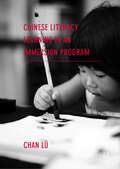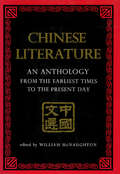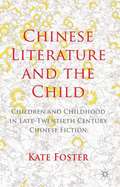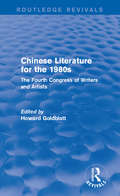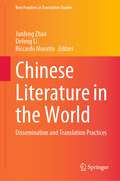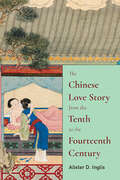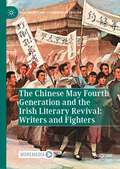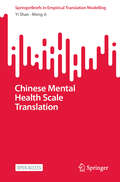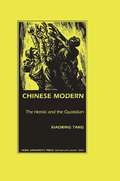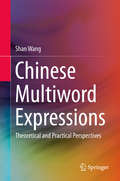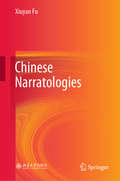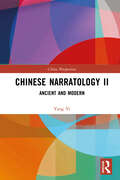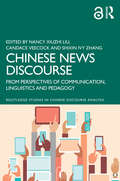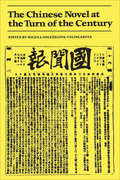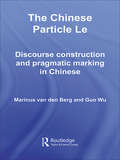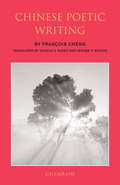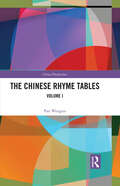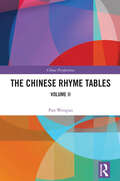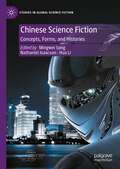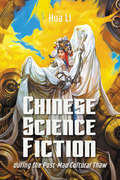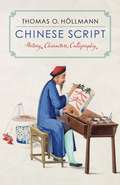- Table View
- List View
Chinese Literacy Learning in an Immersion Program
by Chan LüThis book examines one-way foreign language immersion education in the United States. It provides a clear and rich description of a Chinese (Mandarin) immersion program, its curriculum, instructional materials, assessment activities, parental involvement and student outcomes. The author analyses two studies that document the development of the students’ reading skills in English and Chinese, and the progress of their vocabulary knowledge, lexical inference, and reading comprehension in Chinese. In addition, this book contextualizes the program in its eco-system, including its neighbourhood, school, and the school district, and discusses the importance of school leadership, parental involvement, neighbourhood support and language acquisition planning in making an innovative school program successful. Its concluding chapters offer recommendations for program- and classroom-level practices and suggest pathways for future research on biliteracy learning in Chinese one-way immersion programs. This book will appeal in particular to students and scholars of applied linguistics, second language acquisition and language education.
Chinese Literature
by William McnaughtonAlmost three thousand years of Chinese literature have been gathered together in Chinese Literature: An Anthology from the. Earliest Times to the Present Day. The earliest preserved folk songs of the peasantry; the major works of the "Golden Age" of Chinese philosophy; the "prose-songs" and the later skillful poems of the T'ang dynasty ; the short stories and plays; the novels ; andthe poems and stories of men who have made modern China - all these are represented in this anthology, in complete works or in excerpts.
Chinese Literature And The Child
by Kate FosterChinese Literature and the Childis a far-reaching study of images of children in post-Cultural Revolution novels and short stories. Considering works from over twenty writers, including some of China's leading literary stars, this book spans two decades of China's recent and rapid transformation. Tracking ideas of the child in Chinese society across the twentieth century, Kate Foster places fictional children within the story of the nation in a study of tropes and themes which range from images of strength and purity to the murderous and amoral. In this ambitious and revealing study, Foster views China's imagined children in relation to major shifts in Chinese culture and society and through literary theory, and argues convincingly for the significance of the child in fiction in the construction of adult identity in a time of change.
Chinese Literature for the 1980s: The Fourth Congress of Writers and Artists (Routledge Revivals)
by Howard GoldblattEditor Howard Goldblatt explains that while most societies analyse and revere their literary trends in retrospect, post-Liberation China’s literary trends tend to be announced beforehand allowing for critics to judge how close or far from the prescribed norms a piece of art is. In this volume, a collection of speeches and reports from the Fourth Congress of Writers and Artists, well-known Chinese writers (novels, poets, and dramatists alike) debate the future direction of Chinese literature for the 1980s. Originally published in 1982, the book lends a contemporary view into the state of art and literature in China during a critical era of transformation. This title is suitable for students of Literature and East Asian Studies.
Chinese Literature in the World: Dissemination and Translation Practices (New Frontiers in Translation Studies)
by Junfeng Zhao Defeng Li Riccardo MorattoThis book features a collection of articles on comparative literature from a translational perspective, with a special reference to translation of contemporary Chinese literature. Issues of translation, dissemination, and reception of translated literature in the context of world literature are the foci of the book. Given its scope, the book appeals particularly to teachers and students of Chinese literature, translation, and Sinology.
The Chinese Love Story from the Tenth to the Fourteenth Century (SUNY series in Chinese Philosophy and Culture)
by Alister D. InglisLove stories formed a major part of the classical short story genre in China from as early as the eighth century, when men of letters began to write about romantic encounters. In later centuries, such stories provided inspiration for several new literary genres. While much scholarly attention has been focused on the short story of both the medieval and late imperial eras, comparatively little work has been attempted on the interim stage, the Song and Yuan dynasties, which spanned some five hundred years from the tenth to the fourteenth centuries. Yet this was a crucial developmental period for many forms of narrative literature—so much so that any understanding of late imperial narrative should be informed by the earlier tradition. The first study of its kind in English, The Chinese Love Story from the Tenth to the Fourteenth Century traces the development of the love story throughout this important yet overlooked era. Using Tang dynasty stories as a point of comparison, Alister D. Inglis examines and appraises key new themes, paying special attention to period hallmarks, gender portrayal, and textuality. Inglis demonstrates that, contrary to received scholarly wisdom, this was a highly innovative period during which writers and storytellers laid a fertile foundation for the literature of late imperial China.
The Chinese May Fourth Generation and the Irish Literary Revival: Writers and Fighters (Asia-Pacific and Literature in English)
by Simone O’Malley-SuttonThis book examines how the early twentieth-century Irish Renaissance (Irish Literary Revival) inspired the Chinese Renaissance (the May Fourth generation) of writers to make agentic choices and translingual exchanges. It sheds a new light on “May Fourth” and on the Irish Renaissance by establishing that the Irish Literary Revival (1900-1922) provided an alternative decolonizing model of resistance for the Chinese Renaissance to that provided by the western imperial center. The book also argues that Chinese May Fourth intellectuals translated Irish Revivalist plays by W. B. Yeats, Lady Gregory, Seán O’Casey and Synge and that Chinese peasants performed these plays throughout China during the 1920s and 1930s as a form of anti-imperial resistance. Yet this literary exchange was not simply going one way, since Yeats, Lady Gregory, Synge and O’Casey were also influenced by Chinese developments in literature and politics. Therefore this was a reciprocal encounter based on the circulation of Anti-colonial ideals and mutual transformation.
Chinese Mental Health Scale Translation (New Frontiers in Translation Studies)
by Yi Shan Meng JiThis open access book illustrates the key steps and procedures of developing mental health scales into linguistically and culturally appropriate translations. Through illustrative case studies, we demonstrate that traditional forward and backward translation have significant methodological limitations when applied in mental health scale translation, such as linguistic and cultural inaccessibility and inaccuracy in the clinic. Our book will stimulate more academic debates and further systematic research into the significant, interdisciplinary area of mental health translation, which has been underexplored in Translation Studies.
Chinese Modern: The Heroic and the Quotidian
by Xiaobing TangChinese Modern examines crucial episodes in the creation of Chinese modernity during the turbulent twentieth century. Analyzing a rich array of literary, visual, theatrical, and cinematic texts, Xiaobing Tang portrays the cultural transformation of China from the early 1900s through the founding of the People's Republic, the installation of the socialist realist aesthetic, the collapse of the idea of utopia in the aftermath of the Cultural Revolution, and the gradual cannibalization of the socialist past by consumer culture at the century's end. Throughout, he highlights the dynamic tension between everyday life and the heroic ideal. Tang uncovers crucial clues to modern Chinese literary and cultural practices through readings of Wu Jianren's 1906 novel The Sea of Regret and works by canonical writers Lu Xun, Ding Ling, and Ba Jin. For the midcentury, he broadens his investigation by considering theatrical, cinematic, and visual materials in addition to literary texts. His reading of the 1963 play The Young Generation reveals the anxiety and terror underlying the exhilarating new socialist life portrayed on the stage. This play, enormously influential when it first appeared, illustrates the utopian vision of China's lyrical age and its underlying discontents--both of which are critical for understanding late-twentieth-century China. Tang closes with an examination of post-Cultural Revolution nostalgia for the passion of the lyrical age. Throughout Chinese Modern Tang suggests a historical and imaginative affinity between apparently separate literatures and cultures. He thus illuminates not only Chinese modernity but also the condition of modernity as a whole, particularly in light of the postmodern recognition that the market and commodity culture are both angel and devil. This elegantly written volume will be invaluable to students of China, Asian studies, literary criticism, and cultural studies, as well as to readers who study modernity.
Chinese Multiword Expressions: Theoretical and Practical Perspectives
by Shan WangThis book is the first English monograph to systematically explore Chinese Multiword expressions (MWEs) by applying corpus-driven and corpus-based approaches. It reveals the unique characteristics of Chinese MWEs by examining their core attributes, identification and classification, and knowledge framework. It also assesses, for the first time, the distribution and density of Chinese MWEs in textbooks. By doing so, the book provides important insights into Chinese language learning, with implications for natural language processing, lexicography, and psychology. Moreover, it offers a framework for linguists, language teachers and learners, computer scientists, lexicographers, and psychologists to explore their own areas of interest.
Chinese Narrative Poetry: The Late Han Through T'ang Dynasties
by Dore J. LevyChinese Narrative Poetry brings a new perspective to some of China's best-loved and most influential poems, including Ts'ai Yen's "Poem of Affliction," Po Chu-yi's "Song of Everlasting Sorrow," and Wei Chuang's recently discovered "Song of the Lady of Ch'in." Composed in the shih form during the Late Han, Six Dynasties, and T'ang periods, these poems stand out as masterworks of narrative art. Yet paradoxically, their narrative qualities have been little recognized or explored in either traditional Chinese or modern Western scholarship. The reason for this neglect is that Western literary traditions acknowledge their origins in epic poetry and thus take narrative for granted, but the Chinese tradition is fundametally based on lyric and does not admit of a separate category for narrative poetry.Drawing on both classical Chinese critical works and the most recent Western contributions to the theory of narrative, Levy shows how narrative elements developed out of the lyrical conventions of shih. In doing so, she accomplishes a double purpose, guiding the modern reader to an understanding of the nature of narrative in Chinese poetry and shedding light on the ways in which Chinese poets adapted the devises of lyric to the needs of a completely different expressive mode.Students of Chinese literature will welcome this pathbreaking study, but Chinese Narrative Poetry will interest other scholars as well because it addresses questions of crucial importance for literary theory and comparative literature, particularly the central issue of the applicability of Western critical concepts to non-Western literature and culture.
Chinese Narratologies
by Xiuyan FuThis book provides a more rational and systematic explanation for the origin and evolution of the Chinese narrative tradition, based on studies of Chinese literary classics, local culture and items such as bronze wares and porcelain vessels with “portrayed stories.” By doing so, it uncovers forgotten interconnections and reestablishes obscured or unacknowledged lines of descent. Furthermore, it makes an initial study of acoustic narrative. Going beyond the field of literature, it employs tools and materials from diverse fields such as anthropology, religious studies, mythology, linguistics, semiotics, folklore and local culture. The book also offers an archeological inquiry into the knowledge found in various narrative texts, objects with “portrayed stories” and perceptions with “relevant plots.” Providing a wealth of insights, inspiring investigative methods and practical tools that can be applied in narrative studies, the book is an essential resource for researchers and students in the fields of comparative literature, narratology and ancient Chinese literature.
Chinese Narratology I: Heaven and Human (China Perspectives)
by Yang YiAs the first volume of a two-volume set on Chinese narratology, this title introduces the cultural fundamentals that nurture Chinese literary works and investigates the structure and time of Chinese narrative. In the introductory chapter, the author examines the intrinsic association between Chinese writers’ narrative techniques and China’s cultural background by putting forward a Principle of Duixing to facilitate the study of those techniques and three steps to revisit Chinese narrative. Based on Western narrative theories and a close reading of outstanding Chinese literary classics, the volume focuses on structure and time in Chinese narrative. The first part on structure (jiegou) identifies five essential themes to analyze the dual dynamic structure of Chinese narrative. In terms of aspects of time, the author demonstrates how the holistic view of time and space in the Chinese tradition influences the chronological framework of narratives and shapes the outset of a story. The book is a must-read for scholars and students interested in narrative theory, Chinese culture and literature, and the dialogue between Chinese and Western narratological studies.
Chinese Narratology II: Ancient and Modern (China Perspectives)
by Yang YiAs the second volume of a two-volume set on Chinese narratology, this title investigates the quintessential characteristics of the Chinese narrative style, with a focus on image and perspective.The first chapter introduces two opposing concepts of perspective: “focalization” and “blind spot,” to connect “perspective” with traditional aesthetics, highlighting the mutual relation of the nonexistent and the existent. The author believes that both the narrator and perspective are central to the narrative forms and strategies adopted by Chinese writers and that study of the narrator and perspective is integral to understanding the cultural, aesthetic, and philosophical connotations of the narrative text and the spiritual world of the author. Drawing on perceptual phenomenology, the chapter on image broadens the extant knowledge of “image” and points out that image narration is unique to Chinese narratology and central to Chinese aesthetics. The final chapter illustrating the achievements of influential critics of classical Chinese novels, proving that these critics have contributed to the canonization of the genuine masterpieces of Chinese narrative literature.The book is a must-read for scholars and students interested in narrative theory, Chinese culture and literature, and dialogue between Chinese and Western narratological studies.
Chinese News Discourse: From Perspectives of Communication, Linguistics and Pedagogy (Routledge Studies in Chinese Discourse Analysis)
by Nancy Xiuzhi Liu , Candace Veecock and Shixin Ivy ZhangAs a country in transition, Chinese news discourse has quite distinctive characteristics, and more so given the power of state media in society. With China’s engagement in world affairs and its massive Belt and Road Initiative (BRI) now in place, Western media coverage of China has dramatically increased. Against this backdrop, news dissemination and discourse demonstrate a need for academia to give perspectives with interdisciplinary approaches. Chinese News Discourse presents original research from academics in China and the West, showing theoretical, methodological and practical dimensions between news media and discourse. The book focuses on Chinese news discourse by examining what new modern features it demonstrates in contrast and comparison to news discourses in other countries in the coverage of such hot topics as the BRI or the 70th Anniversary of the Founding of the People’s Republic of China, just to name a few. This book is a useful resource for scholars and students of discourse, language, media and communication studies, as well as translation studies.
The Chinese Novel at the Turn of the Century
by Milena Dolezelova-VelingerovaThis collection of essays reveals the dynamic role of the late Qing novel in the process of modernization of Chinese fiction. Substantial changes in various aspects of the Chinese novel at the turn of the century, demonstrated by structural analyses of several representative novels, suggest that the evolution of modern Chinese fiction was a more complex process than a simple imitation of Western literatures. The results challenge the scholarly consensus that modern Chinese fiction resulted from a radical change brought about by the May Fourth Movement in 1919. It is demonstrated rather that the transformation had already begun in the first decade of the twentieth century and that the conspicuous changes in Chinese fiction of the 1920s represent a culmination rather than a beginning of the modern evolutionary process. The book consists of nine studies which analyse the late Qing novel in its general and specific aspects. The introduction and first essay explain how social changes conditioned cultural and literary changes during the period and how the resultant new theory of fiction generated new concepts of a politically engaged novel. The two following studies develop a general statement of narrative structures and devices, derived from structural analyses of seven outstanding late Qing novels. The last six articles examine particular novels in detail, focusing on the specific fictional techniques which predominate in each. This is the first volume in a new series, Modern East Asian Studies.
The Chinese Particle Le: Discourse Construction and Pragmatic Marking in Chinese (Routledge Studies in Asian Linguistics)
by M.E. van den Berg G. WuEver since the start of Chinese linguistic studies, the description of the Chinese particle LE has remained elusive. The classification has evolved from a listing of sentences and the discussion of contrastive pairs to a more context and discourse-oriented analysis. The development in recent years of inferential models and situation semantics has opened the way for a renewed study of the use of the Chinese particle LE. This book discusses the Chinese data from a 'mental space' perspective and finally reveals the role so-called Chinese 'sentence LE' plays in the construction and maintenance of discourse.
Chinese Poetic Writing
by Donald Riggs Francois Cheng Jerome SeatonThe most inovative study of Chinese poetry ever written, François Cheng's Chinese Poetic Writing--now in its first expanded, English-language edition--is an essential read for fans and scholars of Chinese literature and the art of poetry in general. Since its first publication in French in 1977, Chinese Poetic Writing has been considered by many to be the most innovative study of Chinese poetry ever written, as well as a profound and remarkable meditation on the nature of poetry itself. As the American poet Gustaf Sobin wrote, two years after the book’s appearance, “In France it is already considered a model of interdisciplinary research, a source book, and a ‘star’ in the very space it initially explored, traced, and elaborated.” Cheng illustrates his text with an annotated anthology of 135 poems he has selected from the Tang dynasty, presented bilingually, and with lively translations by Jerome P. Seaton. It serves as a book within the book, and an excellent introduction to the golden age of Tu Fu, Li Po, Wang Wei, and company. The 1982 translation, long out of print, was based on the first French edition. Since then, Cheng has greatly expanded the book. This is the first English-language edition of the expanded version, with the original translators returning to accommodate the many new additions and revise their earlier work.
Chinese Political Discourse in Translation: A Corpus-based Critical Discourse Analysis (Routledge Advances in Translation and Interpreting Studies)
by Lijuan DuBuilding on Fairclough’s critical discourse analysis (CDA) framework, Du examines the official translators’ agency in reconstructing the image of China. Comparing the source text and target text, her book focuses on ideologically striking translation shifts that occur at different levels.Drawing on the Seven Reports to the National Congresses of the Communist Party of China (CPC) (1992-2022) as a corpus, Du explores the official translators’ agency in representing the image of China, as well as the recontextualization of the translated discourse of the Report to the National Congress of the CPC in the international media. She delves into the balance between discourse, ideology, and political and social function, and argues that at their essence, discourse changes by the translator represent a change of ideology, and the acquisition of discourse power is the manifestation of ideological power.Striking the balance between theoretical and empirical studies, this book reveals the role of discourse in building the media view of China, corroborating the interrelationship between discourse and ideology. The book will be of interest to researchers and postgraduate students of discourse analysis, corpus linguistics, and media studies.
Chinese Reportage
by Charles A. LaughlinChinese Reportage details for the first time in English the creation and evolution of a distinctive literary genre in twentieth-century China. Reportage literature, while sharing traditional journalism's commitment to the accurate, nonfictional portrayal of experience, was largely produced by authors outside the official news media. In identifying the literary merit of this genre and establishing its significance in China's leftist cultural legacy, Charles A. Laughlin reveals important biases that impede Western understanding of China and, at the same time, supplies an essential chapter in Chinese cultural history. Laughlin traces the roots of reportage (or baogao wenxue) to the travel literature of the Qing Dynasty but shows that its flourishing was part of the growth of Chinese communism in the twentieth century. In a modern Asian context critical of capitalism and imperialism, reportage offered the promise of radicalizing writers through a new method of literary practice and the hope that this kind of writing could in turn contribute to social revolution and China's national self-realization. Chinese Reportage explores the wide range of social engagement depicted in this literature: witnessing historic events unfolding on city streets; experiencing brutal working conditions in 1930s Shanghai factories; struggling in the battlefields and trenches of the war of resistance against Japan, the civil war, and the Korean war; and participating in revolutionary rural, social, and economic transformation. Laughlin's close readings emphasize the literary construction of social space over that of character and narrative structure, a method that brings out the critique of individualism and humanism underlying the genre's aesthetics. Chinese Reportage recaptures a critical aspect of leftist culture in China with far-reaching implications for historians and sociologists as well as literary scholars.
The Chinese Rhyme Tables: Volume I (China Perspectives)
by Pan WenguoAs the first volume of a two-volume set that studies Chinese rhyme tables, this book focuses on their emergence, development, structure, and patterns. Rhyme tables are tabulated tool constituted by phonological properties, which helps indicate the pronunciation of sinograms or Chinese characters, marking a precise and systematic account of the Chinese phonological system. This volume first discusses the emergence of the model and factors that determined its formation and evolution, including the Chinese tradition of the rhyme dictionary and the introduction of Buddhist scripts. The second part analyzes the structure and arrangement patterns of rhyme tables in detail, giving insights into the nature of “division” (deng): the classification and differentiation of speech sounds, of vital significance in the reconstruction of middle Chinese. The author argues that deng has nothing to do with vowel aperture or other phonetic features but is a natural result of rhyme table arrangement. He also reexamines the principles for irregular cases (menfa rules) and categorizes the 20 rules into three types.The book will appeal to scholars and student studying linguistics, Chinese phonology, and Sinology.
The Chinese Rhyme Tables: Volume II (China Perspectives)
by Pan WenguoAs the second volume of a two-volume set that studies the Chinese rhyme tables, this book seeks to reconstruct the ancient rhyme tables based on the extant materials and findings. A rhyme table is a tabulated tool constituted by phonological properties, which helps indicate the pronunciation of sinograms or Chinese characters, marking an accurate and systematic account of the Chinese phonological system. The book first explores the relationship and identifies the prototype of the extant rhyme tables. Then the principles and methods for collating and rebuilding the ancient rhyme table are introduced. It then looks at the general layout, including tables, table order, shè, zhuǎn, rhyme heading, rhyme order, light and heavy articulations, rounded and unrounded articulations, and initials. The final chapter presents the reconstructed rhyme tables with detailed annotations and add-on indexes. The book will appeal to scholars and students studying Sinology, Chinese linguistics, and especially Chinese phonology.
Chinese Science Fiction: Concepts, Forms, and Histories (Studies in Global Science Fiction)
by Mingwei Song Nathaniel Isaacson Hua LiThis volume brings together emerging approaches and addresses shifting paradigms in Chinese science fiction studies, offering a window on fan cultures, internet fiction, gender, eco-criticism, post-humanism and biomedical discourse. These studies present a “second wave” of Chinese sf studies, re-evaluating the canon of Chinese sf print and cinematic production, and expand the range of critical approaches to the subject. The structure of the volume is both chronological and theme-focused. These studies also demonstrate that Chinese science fiction represents a significant contribution to modern Chinese cultural production, both in terms of its value, speaking powerfully to our modern condition, and its sheer volume in terms of production and consumption. Chinese science fiction speaks to both China’s rapidly shifting reality, its political multiplicity and its formless future, voicing the anticipations and anxieties of a new epoch filled with accelerating alterations and increasing uncertainty.
Chinese Science Fiction during the Post-Mao Cultural Thaw
by Hua LiThe late 1970s to the mid-1980s, a period commonly referred to as the post-Mao cultural thaw, was a key transitional phase in the evolution of Chinese science fiction. This period served as a bridge between science-popularization science fiction of the 1950s and 1960s and New Wave Chinese science fiction from the 1990s into the twenty-first century. Chinese Science Fiction during the Post-Mao Cultural Thaw surveys the field of Chinese science fiction and its multimedia practice, analysing and assessing science fiction works by well-known writers such as Ye Yonglie, Zheng Wenguang, Tong Enzheng, and Xiao Jianheng, as well as the often-overlooked tech–science fiction writers of the post-Mao thaw. Exploring the socio-political and cultural dynamics of science-related Chinese literature during this period, Hua Li combines close readings of original Chinese literary texts with literary analysis informed by scholarship on science fiction as a genre, Chinese literary history, and media studies. Li argues that this science fiction of the post-Mao thaw began its rise as a type of government-backed literature, yet it often stirred up controversy and received pushback as a contentious and boundary-breaking genre. Topically structured and interdisciplinary in scope, Chinese Science Fiction during the Post-Mao Cultural Thaw will appeal to both scholars and fans of science fiction.
Chinese Script: History, Characters, Calligraphy
by Thomas O. HöllmannIn this brisk and accessible history, sinologist Thomas O. Höllmann explains the development of the Chinese writing system and its importance in literature, religion, art, and other aspects of culture. Spanning the earliest epigraphs and oracle bones to writing and texting on computers and mobile phones today, Chinese Script is a wide-ranging and versatile introduction to the complexity and beauty of written text and calligraphy in the Chinese world.Höllmann delves into the origins of Chinese script and its social and political meanings across millennia of history. He recounts the social history of the writing system; written and printed texts; and the use of writing materials such as paper, silk, ink, brush, and printing techniques. The book sheds light on the changing role of literacy and education; the politics of orthographic reform; and the relationship of Chinese writing to non-Han Chinese languages and cultures. Höllmann explains the inherent complexity of Chinese script, demonstrating why written Chinese expresses meaning differently than oral language and the subtleties of the relationship between spoken word and written text. He explores calligraphy as an art, the early letter press, and other ways of visually representing Chinese languages. Chinese Script also provides handy illustrations of the concepts discussed, showing how ideographs function and ways to decipher them visually.
